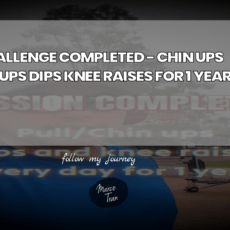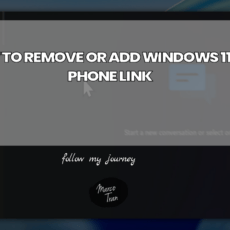The thrill of unboxing a new pair of performance running shoes never really fades, does it? There’s a moment of pause, a simple “So…” as you lift the lid and finally see what all the anticipation was for. That was the tone of my first look at the Under Armour Velociti Elite 2 STR—a shoe clearly designed with racing in mind and a bold promise of speed, energy return and an uncompromisingly responsive ride. From initial handling through the first short run, here’s how the experience unfolded and what stood out straight away.
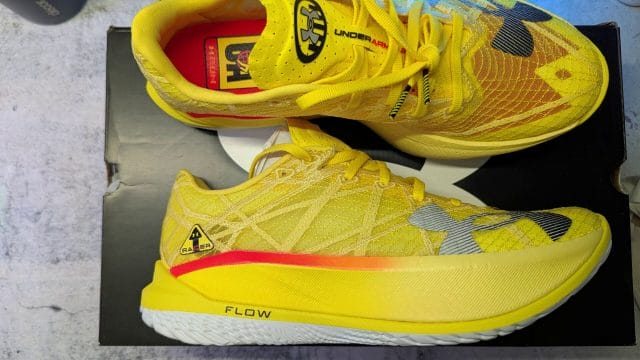
Packaging and Presentation
Under Armour typically keeps things sharp and straightforward with their packaging, and the Velociti Elite 2 STR arrives in a box that feels premium without unnecessary frills. Sliding the shoes out, you immediately sense the purpose-built design: a sculpted midsole profile, a race-focused upper, and the kind of stiffness you associate with top-tier competition footwear. That initial “So…” reflects a moment of taking stock—these aren’t everyday trainers; they look and feel like they were built for speed and efficiency. The materials appear finely tuned: airy yet structured, and the midsole has that telltale spring when you press a thumb into it.
As a member of the elite racing category, the Velociti Elite line is known for prioritising propulsion. Many modern race shoes incorporate a rigid plate and highly resilient foam to deliver that “catapulting” sensation during toe-off. Without diving into the official spec sheet here, the feel in hand and underfoot suggests a combination engineered for responsiveness and quick turnover. The outsole appears strategically mapped for traction without adding bulk, and the upper’s profile hints at a snug, performance-oriented fit intended to hold the foot steady when you’re moving quickly. In short, expectations are rightly high: energy return, lightweight construction, and race-day focus.
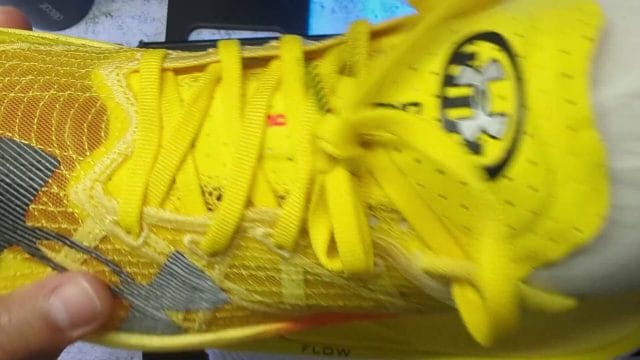
Early Concerns and a Balanced View
Alongside the excitement, there’s a candid admission: “But when I think that they should, I think they have a lot of cons.” That’s a valuable reminder that high-performance footwear often involves trade-offs. Super shoes tend to be specialised tools rather than generalists. Common drawbacks you might encounter include a narrower platform that can feel less stable at slower speeds, an upper that’s more rigid or minimal than everyday trainers, and midsoles that prioritise propulsion over soft, plush comfort. Some runners notice that the aggressive rocker and stiff structure require an adjustment period. None of these are deal-breakers, but they are worth acknowledging if you’re transitioning from more traditional training shoes.

Who Will Notice the Drawbacks Most?
If you tend to prefer cushioned, forgiving rides for long steady miles, the sharper, springy feel of a racing shoe might initially feel alien. Similarly, if your foot has a wider profile or you rely on padding for comfort, the refined, low-volume upper may feel snug at first. The geometry can also be polarising: the rocker encourages forward momentum and quick transitions, which is brilliant at pace but may feel awkward during easy jogs or on tight corners. Again, these are characteristics of the category rather than flaws in isolation—it’s about matching the shoe to the intended use.
Fit, Feel and That Bouncy Ride
“I’m not really used to it. I mean the shoe is very bouncy.” That’s the hallmark reaction to modern race-focused midsoles. Bounciness tends to arise from high-energy foams designed to compress and rebound quickly, helping you waste less energy during ground contact. Paired with a stiffening element (commonly a plate), this can create a distinctive sensation: the shoe encourages you forward, and toe-off becomes strikingly snappy compared to daily trainers. For some, it feels like running on mini trampolines—fun, fast, but definitely different. If you haven’t used a shoe like this before, expect a learning curve and consider shorter, controlled runs to dial in your stride before going long.

Tight at the Top? Let’s Talk Socks and Upper Volume
“It was a little bit tight for my right hand side at the top of the shoe.” Fit variations between left and right feet are common, and race uppers leave less margin for error. The confession that thicker socks may be a culprit is spot on: sock thickness directly affects the perceived volume of a shoe. Switching to a thinner pair can quickly relieve pressure across the top of the foot, allowing the upper to seat more comfortably without over-compressing. If a change of socks isn’t enough, try adjusting the lacing method. Window lacing (skipping an eyelet over the pressure area) can reduce top-of-foot tightness, while a heel-lock technique can secure the rearfoot without over-tightening the midfoot. It’s also worth giving the shoe a few short runs to let the upper mould to your foot shape—many performance fabrics relax slightly with heat and motion.
Adapting to Bouncy Shoes: Tips for a Smoother Transition
When a shoe feels unusually springy, technique and route selection can help. Start with 20–30 minute easy-to-moderate runs to acclimate. Keep to flatter terrain initially; the rocker and stiffness may feel strange on hills or uneven paths. Pay attention to cadence—bouncy shoes often shine when you maintain a slightly higher step rate, reducing overstriding and helping the midsole do its job efficiently. If you notice hotspots across the top of the foot, experiment with different lacing tensions and eyelet patterns before ruling out the fit. In many cases, small adjustments make a disproportionately big difference.
First Test Runs: Early Verdict
“So far so good. I’m going to give it a try in a couple of more times.” That’s the right mindset with any new race shoe. The initial miles give you a baseline; subsequent runs reveal how the shoe behaves across different paces and conditions. Try a progression run—starting easy, building to moderate or tempo—and note how the shoe’s personality changes as speed increases. Many race-focused designs feel merely decent at easy pace but come alive when you push. Surface matters too: dry tarmac is ideal for assessing traction, while light track sessions can highlight turnover. If your first outing felt bouncy yet unfamiliar, the second and third can clarify whether that bounce translates into genuine efficiency gains for your stride.

Tuning Fit and Ride Over Time
After a few runs, revisit the fit. If the top-of-foot pressure persists, try window lacing to create a “gap” over the sensitive area, or redistribute tension by tightening lower eyelets and loosening the middle ones. If heel movement appears, a runner’s loop (heel-lock) can secure the rearfoot without clamping the midfoot. Don’t underestimate sock choice: thin technical socks provide more room, better moisture management and can reduce friction. If you’re between sizes, insoles and lace tweaks can fine-tune the hold, but the best solution is always to try shoes later in the day (when feet are slightly more swollen) to ensure the fit reflects real-world conditions. Over time, you may find the upper matures with your foot shape, and the bouncy feel settles into a more predictable, efficient rhythm.
Pros and Cons: A Thoughtful Balance
Every performance shoe has strengths and compromises. Here’s a balanced snapshot based on early impressions and common characteristics of elite racing footwear.
- Pros: Exceptionally responsive underfoot—ideal for faster efforts; lightweight build keeps the legs feeling fresher at pace; structured upper that secures the foot for confident toe-offs; rocker geometry that encourages forward momentum and efficient transitions.
- Cons: Fit can run snug, especially across the top of the foot with thicker socks; stability may feel less forgiving at slow speeds or on uneven surfaces; the ride may require a few runs to acclimate, particularly if you’re used to plush trainers; specialised nature means it’s best reserved for workouts and racing rather than daily mileage.
Who Should Consider the Velociti Elite 2 STR?
If you’re chasing personal bests over road distances and prefer a shoe that rewards quicker turnover, this category could be a strong match. Neutral runners who enjoy a firm, propulsive feel will likely get the most out of it. Those who thrive when cadence is high and ground contact is brief often find bouncy, plate-assisted designs amplify their strengths. If you’re a stability-seeking runner or prefer a soft, enveloping fit, consider testing thoroughly before committing; the precise fit and lively midsole can feel less forgiving. For training, it can serve well in tempo runs, intervals and dress rehearsals for race pace. For racing, it’s intended to help conserve energy and return more of what you put in—when the fit is dialled.
Sizing, Socks and Lacing: Practical Advice
Given the note about tightness on the right foot, start with thin performance socks to unlock more room. If your feet are slightly asymmetrical (many are), tailor the lacing on each shoe independently—there’s no rule saying both must be tied identically. Experiment with window lacing to relieve pressure, and runner’s loop for heel security. If your toes feel compressed, loosen the forefoot laces before heading out, then gradually tighten after the first kilometre once the foot warms and settles. If choosing between sizes, compare fits later in the day and test with the socks you intend to race in. Minor tweaks can transform the upper from “a touch tight” to “precisely snug.”
Care, Maintenance and Durability
Performance foams and racing outsoles often trade some durability for speed. To prolong the life of your Velociti Elite 2 STR, rotate them with daily trainers and save them for workouts and race days. Avoid rough, abrasive surfaces where possible. After wet runs, air-dry at room temperature—no radiators or direct heat—and stuff with paper to wick moisture and preserve shape. Brush away dust or grit from the outsole after each outing, and occasionally check the midsole for compression lines; these are normal but keeping the shoes offloaded between runs helps them rebound fully. Store them in a cool, dry place, and keep the laces loose to reduce stress on the eyelets.
Final Thoughts and Next Steps
Those initial “So…” moments captured the mix of excitement and caution that comes with testing a specialised shoe. The Under Armour Velociti Elite 2 STR feels distinctly bouncy and engineered for speed. There are genuine pros—energy return, secure hold, lightweight build—and understandable cons—snugness, a learning curve, and a ride best suited to faster efforts. With thinner socks and a few lacing adjustments, early tightness across the top of the foot can often be resolved. The plan now is simple: a few more runs at varying paces to see how the shoe performs when it matters most. If you’re curious, approach it as a tool for specific sessions and races, give yourself time to adapt, and be willing to tweak the fit. So far, so good—and as with any promising race shoe, the true verdict comes once you’ve tested it at your intended pace. I’ll report back after a few more outings. Until then, enjoy your miles and choose the gear that helps you run your best.
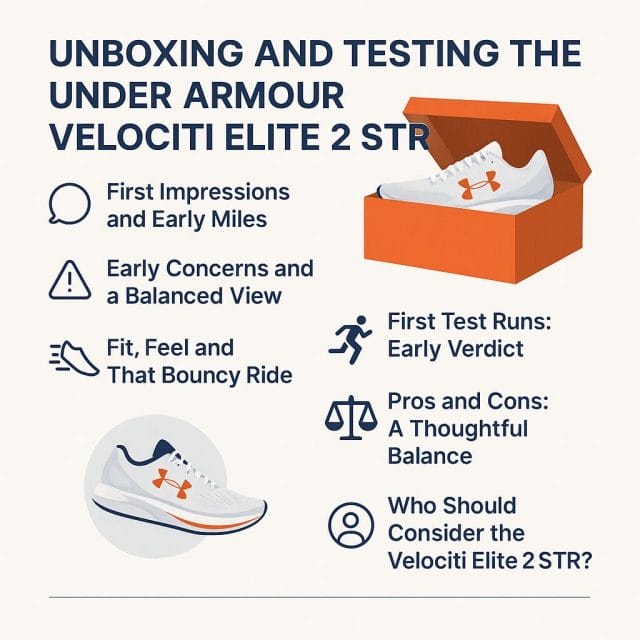

If this article helped you in any way and you want to show your appreciation, I am more than happy to receive donations through PayPal. This will help me maintain and improve this website so I can help more people out there. Thank you for your help.


